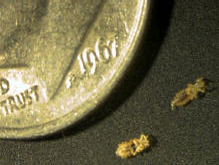A Parent’s Guide
(Which came first, the itchin’ or the egg?)
What is it?
An insect found mostly on the head, but can also be found on the body. Lice are extremely common, an estimated 6-12 million infestations occur each year in the United States among children ages 3-11. You are not alone!
Who is at risk?
Infestation is most common among pre-school and elementary school aged children, their household members, and caretakers.
How is it spread?
Lice do not hop or jump or fly. They crawl. They spread from person to person contact during such activities as
Are there symptoms?
Where should I look?
Close to the scalp behind the ears and at the neckline in the back of the head. If you do not see crawling lice, look within a 1/4 inch of the base of the hair shaft for nits to be attached. A fine toothed louse comb may help you find lice since they are small, move quickly and avoid light. If you find nits more than 1/4 from the scalp, these are almost always hatched or dead.
 Nits, Nymphs and adults
Nits, Nymphs and adults
Nits are lice eggs. They are yellow or white, smaller than a grain of rice and difficult to see. They are often confused with dandruff. Nymphs are baby lice, reddish brown in color and grow to adult lice in about 7 days. Adult lice are about the size of a small grain of rice and are pictured next to a dime in the photo. Adult lice live about 30 days
Do you get lice from pets or animals?
No. (That was an easy one)
All right, were scratching, now what?
First treat the infected person by following the label directions. If the person has long hair 2 treatment kits may be needed.
Remove clothing before treating (clothing may be infested)
Work under bright light (sunlight, bright indoor lamp)
Do NOT use crème rinse or conditioning shampoo before treatment
Put on clean clothes after treatment
Comb dead and remaining lice out of hair after treatment.
Repeat treatment as necessary, or according to the label directions, in 7-10 days, especially for long or thick hair.
Check treated person for 2 to 3 weeks until you are sure all nits and lice are gone.
These old fashion remedies have been suggested by clients to the Community Health Agency.
Remember it takes at least 7 days of work to be rid of lice. It is important to treat everyone in your home and thoroughly clean your home during these 7 days as eggs may be spread throughout your home. Many prescription remedies don’t work due to their over-use. Medicated shampoos and nit combs are often not enough. You actually need to pick the lice eggs (nits) out of the hair, carpeting, bedding and other furniture. You need to be diligent to make sure all of the lice and their eggs are destroyed.
These suggestions are from clients of the Health Department that have worked over the years.
1. (This treatment takes about 12 hours). This method has been the most successful:
2. Use Felsnaptha Soap (found in most grocery stores with other bar soaps) as a regular shampoo daily for 3 days.
After treatment option #1 or #2, you next need be sure all nits (eggs) are removed. This can be done with your fingers, tweezers or an old toothbrush. With a toothbrush be sure to brush away from the scalp. Be sure to work in bright light and take your time. It is essential all nits be removed. If you do not feel you can effectively remove all of the nits yourself, the following method is recommended (to be done after one of the above treatments has been completed).
Cleaning instructions that are a MUST in addition to treating infested hair:
Contact your healthcare provider or local health department office for additional assistance.